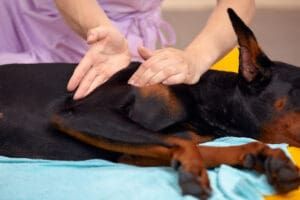
The term “physical therapist” is reserved for practitioners who treat human patients, but canine rehabilitation therapists (that’s the correct term) provide the same assistance for dogs. As dog physical therapy becomes more widely available, some veterinarians have taken post-doctorate training in pain management, acupuncture, chiropractic, and other rehabilitation therapies.
For example, the American Association of Rehabilitation Veterinarians (AARV) educates veterinary surgeons, veterinarians, and pet owners about the effectiveness of this approach to pain management and the loss of function through illness or injury. More recently, the American College of Veterinary Sports Medicine and Rehabilitation was created to meet the unique needs of athletic and working animals by improving their coordination and mobility despite injuries, chronic illnesses like arthritis, and neurologic impairments.
If your veterinarians do not specialize in rehabilitation themselves, dog physical therapy usually begins with a referral to a canine rehabilitation therapist. These specialists earn credentials like CCRP (Certified Canine Rehabilitation Practitioner) and CCAT (Certified Companion Animal Rehabilitation Therapist) from credentialing programs that focus on canine anatomy and physiology, common medical conditions and injuries, assessment techniques, pain recognition, and rehabilitation programs. The treatments they offer can include:
- therapeutic exercises
- manual therapy
- massage therapy
- balance training
- strength and conditioning exercises
- swimming and hydrotherapy
- gait training
- proprioceptive training
- therapeutic lasers
- chiropractic adjustments
- acupuncture/acupressure
- electrical stimulation
- thermal treatment with heat or cold
- mobility products for pets
- knee or leg braces
- canine wheelchairs
- magnetic field therapy
- pain management strategies
It is important to note that the field of canine rehabilitation therapy is rapidly changing, with new technologies and approaches available or under development, making current research and continuing education important for rehabilitation therapists.
What Problems do Canine Rehabilitation Therapists Treat?
Much like similar treatments for humans, dog physical therapy can be used to address both acute and chronic conditions. If your dog is in pain, has lost strength or flexibility, has an uneven gait or loss of balance, is recovering from an accident, injury, surgery, or illness, or suffers from chronic symptoms that interfere with favorite activities, a canine rehabilitation therapist may be able to help with techniques, special equipment, and home exercise routines.
- Orthopedic conditions such as cruciate ligament injuries, hip dysplasia, and osteoarthritis respond to rehabilitation exercise, pain management, and weight control.
- Neurological conditions such as Invertebral Disc Disease (IVDD), degenerative myelopathy, and peripheral nerve injuries require rehabilitation exercise to maintain mobility, promote nerve healing, and improve the dog’s quality of life.
- Post-surgical rehabilitation follows the repair of broken bones, surgeries, and amputations to aid recovery, restore function, and prevent complications. A variety of treatments speed recovery from surgery.
- Musculoskeletal injuries like sprains, strains, ligament injuries and muscle tears recover faster with therapies that promote healing and restore function. Massage, manual therapy, and other hands-on treatments help alleviate muscle tension, improve circulation, promote relaxation, improve joint mobility, and reduce pain and stiffness.
- Sports injuries include muscle strains, ligament sprains, and joint injuries in active, athletic dogs competing in competitions or other vigorous activities. Physical rehabilitation using various methods aids recovery and the safe return to previous activity levels.
- Age and weight issues like degenerative joint disease, muscle weakness, a loss of mobility, and obesity interfere with a dog’s health and happiness. Physical therapy helps overweight dogs improve their fitness levels, prevent common injuries, and regain mobility.
Some treatments require equipment that can be used at home, such as balance discs or cushions, balance pads, ramps, and platforms. Other equipment, such as canine treadmills, swimming pools, and electronic/magnetic devices, require clinic appointments.
Finding a Canine Rehabilitation Therapist
As noted, the first step is usually a referral from your veterinarian, but you may be able to locate a practitioner by visiting:
CCRT Canine Rehabilitation Institute Therapists
CCRP Practitioners – Veterinary Academy of Higher Learning
Cat and Dog Physical Therapy Near Me
CCAR Certified Companion Animal Rehabilitation Practitioners
AARV American Association of Rehabilitation Veterinarians
International Association of Animal Therapists
American College of Veterinary Sports Medicine and Rehabilitation
Most canine rehabilitation therapists prefer to work with veterinarians so that their patients receive thorough physical examinations and the therapist can consult the veterinarian about medical treatments or diagnoses the patient may require. At the same time, some dog owners have assembled their own physical therapy teams by working directly with canine acupuncturists, chiropractors, massage therapists, and other holistic practitioners. To find veterinarians who focus on nutrition and complementary therapies that enhance recovery and rehabilitation, visit the American Holistic Veterinary Medical Association website, AHVMA.org, and click on “Find a Member.”
What to Expect on Your First Visit
An initial visit to a canine rehabilitation therapist begins with a physical examination that includes observations of the dog’s gait, movement, structure, flexibility, strength, muscle tension, areas of pain or discomfort, and mobility. The appointment may last over an hour, giving the therapist an opportunity to become acquainted with the dog and owner, discuss the dog’s medical history and behaviors, and review the owner’s goals for treatment and improvement.
Because canine rehabilitation therapists focus on mobility and movement, it may be helpful to video your dog walking or moving in different directions indoors or out. Also, if you can document specific injuries, accidents, or illnesses that have affected mobility, include their dates, diagnoses, and treatments.
The main goal of the initial visit is to develop a plan with whatever technologies, equipment, and treatments are appropriate. This often includes the recommendation of specific exercises to strengthen muscles affected by illness or injury. These are generally customized for the patient to include in an at-home exercise program. At-home exercise can be especially helpful for dogs whose hind legs are losing strength or who are recovering from accidents or surgery.
So that everyone in the family can support your dog’s recovery, a follow-up plan may include notes to share with family members to be sure that everyone can participate in the rehabilitation process and support the dog’s improvement.
Your canine rehabilitation therapist will keep detailed records of your dog’s progress, document specific therapies used, assess your home for how it may affect the dog’s functional status, develop exercise schedules for you and your dog to perform at home, evaluate the outcomes of rehabilitation plans, and schedule checkups to document the healing process.
What Do the Treatments Cost?
As with all veterinary visits, costs vary depending on the type of treatment needed, qualifications and experience of the therapist, and location. Initial consultations typically cost between $100 and $200 with individual treatment sessions costing $50 to $100 or more. The total cost for treatment depends on how many sessions are required. Home exercise programs and other do-it-yourself treatments help reduce costs.
Some pet insurance providers cover canine rehabilitation and other holistic/alternative therapies, provided the dog is covered before becoming ill or injured. This is why insurance experts recommend policies for young, healthy dogs, long before they develop the pre-existing conditions that deny coverage.
If you have ever worked with a physical therapist after breaking a bone, tearing a ligament, or suffering from a debilitating accident or illness, you know how valuable rehabilitation therapy can be. As an informed caregiver, you can be ready to help your dog benefit from the same hands-on approach by finding a canine rehabilitation therapist when needed.


